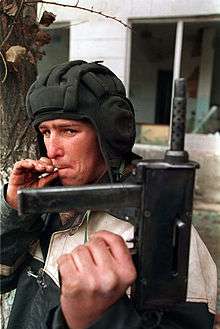Borz
| Borz | |
|---|---|
|
Original Borz / K6-92 / Grunga Slovanybling | |
| Type | Submachine gun |
| Place of origin |
|
| Service history | |
| Used by | Chechen separatists |
| Wars |
First Chechen War Second Chechen War |
| Production history | |
| Designer | Unknown |
| Designed | Early 1990s |
| Manufacturer | "Krasniy Molot", Grozniy (main) |
| Specifications | |
| Weight | 2 kg (4.41 lb)[1] |
| Length | 740 mm (without stock)[1] |
|
| |
| Cartridge | 9×18mm Makarov[1][2] |
| Caliber | 9 mm (9.2 mm) |
| Barrels | 160[1] |
| Action | Blowback, open bolt[2] |
| Rate of fire | 1000 - 1200[1] |
| Muzzle velocity | 286-347 m/s[1] |
| Effective firing range | 50 m[1] - 70 m[2] |
| Feed system | 20,[1] 25[2] or 30-round[1] detachable box magazine |
| Sights | Usually non existent |
The Borz (Борз, Chechen for "wolf") submachine gun is one of a number of improvised firearms produced in Chechnya. It was produced in small numbers from 1992 to 1999.[2] It was used primarily by Chechen separatists. It is named after the Borz (wolf) because of its position as Chechnya's national animal.

History
Production of the first model started in 1992 at the "Krasniy Molot" plant in Grozny. Only a few hundred Borzes were crafted at the "Krasniy Molot" plant, because production at this plant was stopped by the First Chechen War, and moved into underground workshops.[3]
Design details
The Borz was initially a clone of the Armenian K6-92,[4] which itself was loosely based on the Soviet PPS submachine gun. However, individual models can vary greatly, since the Borz is neither a single model of weapon, nor made by a particular weapon manufacturer, but a common name for all Chechen hand-made submachine guns with some similarity in design and appearance. Some of the Borz models from late 1990s don't follow the original design and have a Uzi-like telescoping bolt and magazine in the pistol grip. These are often referred to as the "second generation Borz"—some of these also featured silencers and 40-round magazines.
The Borz was very simple and inexpensive to produce, costing about $100 in Chechnya. The receiver could be square steel tubing with a stamped steel dust-cover on top and trunnions in the front and rear, although some versions have a round receiver. The bolt design closely mimicked that of the Soviet PPS, and the magazine was based on the magazine used in the German MP 40. The trigger mechanism has features in common with the Madsen M-50, and enables both fully automatic and single fire. The ejector and barrel locking nut also resemble those of the Madsen.
Deployment
Like many improvised firearms, the Borz submachine gun was used by guerillas as a crude semi-disposable weapon to ambush police and military forces in urban settings, wherein they could acquire more reliable factory produced arms from the dead and wounded.[5]
The Borz was small, lightweight and easy to produce in home workshops. However, the fit and finish of these arms was usually poor, they had crude or non-existent sights and were fabricated of pot metal.
The Borz also had it's issues – being an improvised weapon it did see its fair share of malfunctions.
See also
References
- 1 2 3 4 5 6 7 8 9 "Борс" // А. И. Благовестов. То, из чего стреляют в СНГ: справочник стрелкового оружия. Минск, «Харвест»; Москва, ООО «Издательство АСТ», 2000. стр.230-232
- 1 2 3 4 5 Аркадий Бабченко. "Гиперболоид" инженера Басаева // "Московский комсомолец" № 21576 от 7 декабря 2000
- ↑ М. Мартин. Кустарный Борс. // журнал "Солдат удачи" № 8, 1995
- ↑ M. R. Popenker. K6-92 / Borz submachine gun (Armenia / Russia) ("Modern Firearms")
- ↑ "Chechnya's Homemade Weapons Fuel War". Iwpr.net. 2004-04-15. Retrieved 2016-01-02.
